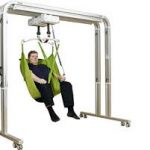Moving and Handling
We aim to provide relevant and timely advice on moving and handling issues in a variety of different environments, i.e. home, day services, and residential/nursing homes. The assessment involves looking at the environment as well as the client and carers needs, to ensure the recommendations we make are practical and achievable. We ensure all moving and handling techniques are in line with current legislation and best clinical practice. Using The Care Team allows rapid access to expert occupational therapy moving & handling services avoiding long NHS or social service waiting lists.
For more information or advice about our range of moving & handling equipment Call:0161 746 7566 or Contact us
Moving & Handling Equipment

It is important that the correct equipment is specified when choosing lifting and handling equipment.
Common lifting and handling issues
- selection of the wrong size sling – which can result in discomfort if the sling is too small, and/or the person slipping through if it is too large. Staff should be aware that sling sizes and coding vary between manufacturers
- wrong type of hoist or sling for the individual, or task – which can lead to inadequate support and a risk of falling. For example, toileting slings give a great degree of access, but little support
- incompatibility of hoist and sling can result in insecure attachment between the two. Follow the manufacturer’s advice and refer any concerns about sling/hoist design, supply, manufacturer’s instructions or compatibility to the MHRA
 , the regulator for medical devices
, the regulator for medical devices - failure of equipment due to lack of maintenance/inspection
- leaving a vulnerable person unattended in a hoist; or in a position where they might be at risk of falling
- overturning of the hoist due to difficult surfaces, transporting an individual over a long distance on a hoist, or not following the manufacturer’s instructions
- failure to use a safety harness, belt or attachment appropriately. Some slings come with different length loops for attachment to the hoist to increase comfort or the range of positions. You must choose the correct loops so that an individual is not at risk of slipping from the sling. Use the same loop configuration on both sides to reduce the risk of sideways falling
The Care Team’s occupational therapy team will provide guidance on;
- which hoist to use for which task
- type and size of sling and any configurations of loops or leg attachments
- use of any additional safety devices such as safety belts
- number of carers needed to carry out the task
- any other relevant information specific to the person being hoisted
